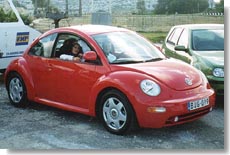|
|
|
 |
| TESTDRIVES |
|
Feature
Date: November/December 1998
|

VW
BEETLE: OLD OR NEW?
Some 44 years and several thousand miles separate the oldest and the latest Volkswagen Beetles featured. The first is a 1954 1200cc beetle and it is one of the earlier examples in Malta of Dr Ferdinand Porsche’s original concept of a People’s Car from which Volkswagen derives it name. The latest Beetle is the new concept as perceived by Ferdinand Piech, Porsche’s nephew, and is as different from its predecessor as night is from day. Whereas the original, designed way back in 1933, was intended to be a means for mobilizing the German people, hence its name, the latest addition to VW’s varied range is intended to be more upmarket as something different for those who can afford to fork out the considerable sum (Lm 12,000 circa) that VW dealers are asking for it. Undoubtedly, both models share the characteristics for which all VWs are renowned, that is, reliability, longevity of service, product quality and engineering excellence, but these are achieved in totally differing ways not only because of the expectations of the different ends of the market at which they are aimed, but also because of the tremendous engineering advances made in the sixty years or so that separate the origination of the two concepts. The older beetle, which has been the subject of a thorough restoration recently, clearly shows its age in comparison to its modern siblings. It lacks any of the power assistance that nowadays people take fore-granted. Its steering is heavier at parking speeds, brakes require a heftier push and pull up the car from speed in a longer distance than their modern equivalents. Cockpit comfort and accessories are spartan in comparison and ride quality is much firmer. Handling and performance are merely adequate by today’s standards. This does not mean that the original beetle was spartan or basic throughout its lifespan. When first announced, the car was meant to be one of the best amongst its contemporaries and exhaustive comparative tests in the mid-thirties were carried out to ensure that these objectives were met. Throughout the long life-span of the model, these objectives were maintained and the later models sported such features as dual circuit brakes, collapsible steering, two speed wipers, dashboard dimmer, starter protection circuitry, seat back safety mechanisms, passenger safety cell and other features which only appeared in other manufacturers’ products at a much later date. Furthermore, the handling characteristics of the earlier models were considerably refined with the advent of radial tyres, a wider wheelbase and double jointed rear suspension.
The latest addition to the Beetle family is a front-engined, front wheel driven car whereas the older concept was powered by an engine in the rear which also drove through the rear wheels. The original was cooled by air whilst the New Beetle is liquid cooled and is available in both petrol and diesel variants. The petrol engine, a 2.0 litre unit, produces 115 bhp in comparison to the lowly 30 bhp generated by its ancestor. The diesel engine, a 1.9 L Turbo Diesel, is also very powerful and performance in both instances is very good with a maximum speed of 185 km/hr and 171 km/hr respectively. Consumption is also very good and easily meets current exhaust emission standards. The interior is spacious, especially at the front whilst a lifting tailgate gives access to the luggage area which is somewhat restricted. Just as in the original car, this can be extended when required by folding down the rear seat back, the only difference being that access to this luggage compartment was very awkward in the original concept because there was no lifting tailgate. The passenger compartment in the New Beetle carries some of the characteristics of the older car which will surely bring back fond memories to many people. These include a large round instrument dial, a flower vase and grab straps for rear-seat passengers. Optional extras available on this model will, however, remind passengers that the New Beetle is up to date with other cars, notwithstanding its strong resemblance to the older version. These include air-conditioning, leather trimmed interior, CD changer and electric sunroof amongst others whilst a radio with six speakers is a standard item.
So, although it draws heavily on the original concept’s shape and reputation, the New Beetle is a thoroughly modern car which sports nice period details which will undoubtedly appeal to those of us who remember or even still use the original Beetle as an everyday car or merely as a Sunday driver. Whether it will be kept in production as long as the original version (1947 - 1975 in Germany and is still in production in Brazil and Mexico) or indeed share its sales success, with over 21 million units sold, or even its film starring role in the Herbie series of Walt Disney movies, is something which only time can tell. What is certain is that since its introduction in the USA and Canada in March this year, VW have produced more than 60,000 units. The car will be available in Europe towards the end of this year and right hand drive models should be available locally around April 1999.
|
|
|
 |
|
|